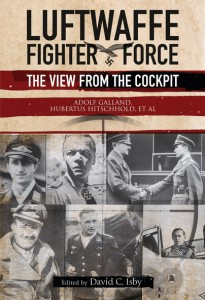The title of this book was so inviting that I eagerly accepted it for a book review. Even more because the picture of Adolf Galland and other German ‘Aces’ decorate the cover.
What really fills this book, instead of the expected ‘cockpit stories’, are the interrogation reports which started directly after the 8th of May 1945 and the captivity of the still living Luftwaffe fighter jet pilots. The USAAF wanted ‘first hand’ insight in the reasons why and how of the Luftwaffe fighter jet effort. The interrogated fighter jet pilots have, without exception, only given way to their ‘neutral business l’ working method. No personal opinions or – dramatic experiences. This was quite different in the in 1950 published ‘Die Ehrsten und Die Letzten’ of Adolf Galland!
Reading of this book soon appeared to be an almost impossible task for me. Every page contains such an avalanche of facts and redirections that I quickly got stuck. After having taken some distance, I decided to approach this book as it was a reference book. With that I at least came to much better manageable ‘chunks’ of information, which provided answers to concrete questions.
This book gives important information about the manner in which Nazi German has deployed her fighter jet capacity and how this has been adapted to the circumstances during the war. It becomes clear that the ‘authorities’ often took decisions without direct feeling with the frontline fighters. The German supreme command also found it difficult to accept that the British choose to continue their already lost (according to the Germans) war with initially, hardly armed 2-engine bombers, which even had to fulfil their missions without the protection of hunters. Often with dramatical losses, but they kept on coming! The estimation of ‘they will stop themselves, no need to react on it too seriously’ appeared to be a misunderstanding which caused a severe time delay. The Luftwaffe, from that moment on, kept running behind on all the facts. Although it was a close call in 1943 when the then German built anti-aircraft defence, in combination with the still developed radar and connection technology and together with the day and night hunters, would not drive the allied bombers losses to an unsustainable height.
Losing more than a hundred bombers in one missions was even for the joint RAF and USAAF almost too much to bear. Especially the deploy of long distance Mustangs and Mosquito’s caused also on the German side, increasing losses of experienced pilots, who, different from the allied, could not provide for new pilots, in unthreatened areas.
When in 1944 the Messerschmidt 262 became available as the first jet-fighter in the world and seemed to make the allied hunters to ‘stand still’ in the air, their tasks initially became to carry bombs. This was Hitler’s personal order! This is also how the last chance ‘to make the difference’ slipped through the fingers of the German jet fighters. Still, the Luftwaffe managed to take allied airplanes down till a day before the capitulation on the 8th of May, with, what by then was called Himmelfahrt Fluge by the German pilots. Because almost no German airplane saw chance to also make a safe landing. But they kept on flying!
The book ends with what it began: lists of types of airplanes including their strong and weak points. And if those were considered before their deploy. On German side the latter was often not the case, because of the rigid ‘persons in charge’ control.
The picture material is pretty elaborate about the German airplane types and their most successful pilots, but, as mentioned, with almost no personal stories. Therefore I find this book as ‘reading book’ a bit less, but as a reference book very fine. For the ones that would like to take it on as a ‘technical manual’, absolutely do!












Leave a Reply